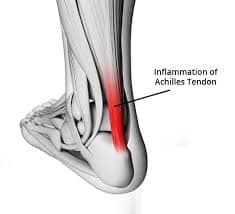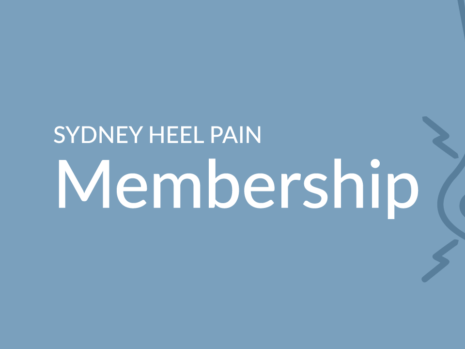Case Study – Achilles Tendon Pain
What Causes Achilles Tendon Pain
A fit and healthy male of Caucasian decent made an appointment at the Sydney heel pain clinic in order to seek treatment for his Achilles tendon pain. He had been feeling discomfort in his left Achilles tendon for more than 6 months and was not improving, regardless of his stretching programme.
He advised the sports Podiatrist that he was feeling this Achilles tendon pain every single day and that it was worse on the days he played tennis. Even on rest days he would wake up and hobble.

He would walk with a significant limp for the first 10 minutes of his day but would feel some slight improvement following his morning shower. He would also carry out some routine calf stretches each morning and following this he would feel slight improvement in the Achilles tendon pain. The discomfort would be greater if he was walking barefoot and to this end he would always try to wear footwear inside his house. This gentleman was a relatively active person and would play tennis three times a week. He would play for approximately 2 hours each time. During the first 20 minutes of tennis he would experience Achilles tendon pain in both ankles, but this would tend to become less painful as the game progressed. He was able to continue playing, but would always feel discomfort if he stopped and rested, and then started to play again. Approximately 1 to 2 hours after the tennis the Achilles tendon pain would return significantly while resting at home. The patient would apply cold ice packs to the Achilles tendon area in order to reduce the discomfort, but the relief was only short lived.
This patient would enjoy a 20 minute walk from the ferry to his office each morning, but this was becoming increasingly difficult. He describes to the sports podiatrist that the Achilles tendon pain would be quite severe if he was to walk up a slight hill or steps. After arriving in his office, while he was seated the Achilles tendon pain would develop into a heat and a significant awareness. If he were to stand up from his office desk and walk to the bathroom or the printer, he would experience significant Achilles tendon pain bilaterally for the first 5 or 10 steps. He was also experiencing a significant stiffness through both ankles.
Massage Therapy for Achilles Tendon Pain
In order to try to relieve the symptoms of the bilateral Achilles tendon pain, this gentleman paid several visits to a massage therapist who performed deep tissue massage on both calf muscles and Achilles tendons. The patient experienced short-term relief which lasted no more than four to six hours. Achilles tendon pain never subsided completely but did ease slightly following each massage. Due to the pain relief , he was drawn back for more appointment’s and further treatment but was becoming increasingly aware that the massage therapy was not addressing the root cause of his problem. The patient stopped attending the massage therapy rooms after 5 sessions over a 3 week period.
Dry Kneedling for Achilles Tendon Pain
A work colleague recommended that he pay a visit to a physiotherapist who could perform dry needling, which may reduce the Achilles tendon pain. Dry needling does come with an analgesic effect which way provide a false positive in some patient’s so should be engaged with caution. This patient did report an improvement in the Achilles tendon pain in one leg more than the other, but that this only lasted for approximately 4 days. After 4 sessions of dry needling the patient decided not to continue with this form of therapy. Dry needling into the calf muscles is a great wat of assisting muscle range and hence helps with movement through the ankles. This also reduces the strain on the Achilles tendon and can help with healing process, providing that all other stressors have been removed and addressed. Short term relief from the Achilles tendon pain is not a reason to continue of the condition is not actually healing.
Shock Wave Therapy for Achilles Tendon Pain
This particular patient enquired about the use of shock wave therapy for treatment of his Achilles tendon pain. The sports Podiatrist explained the benefits of this treatment, being an increase in healing due to stimulation and blood flow / collagen cells. This patient received six sessions of shockwave therapy at 1 week intervals and reported steady improvement following each session. The sports podiatrist also provided specific stretching techniques in order to assist range of motion and to reduce the Achilles tendon pain. The patient was able to continue playing tennis throughout the duration of his treatment which was well tolerated. He was instructed to refrain from physical activity if there was no improvement in his condition during the treatment.
Biomechanical Assessment and the Cause of the Achilles Tendon Pain
The podiatrist performed a biomechanical assessment with the patient walking and running on a treadmill and using digital software his gait cycle and foot function were recorded and analysed in slow motion. The podiatrist was able to determine that there were no long term biomechanical anomalies that would have contributed to the onset of the Achilles tendon pain, but he was able to observe an early heel lift due to the calf muscle tightness. The restricted range of motion through the Achilles tendon would have contributed to significant stress and therefore chronic irritation.
Diagnosis – Achilles Tendon Pain
The patient was informed that the cause of his Achilles tendon pain clearly related to a common condition known as Achilles Tendonitis. As with most patients who undergo shockwave therapy, the Achilles tendonitis was successfully treated and no further Achilles tendon pain was noted following treatment.
The information outlined in this article should not be taken as general advice and if you are suffering with Achilles Tendonitis pain or any other form of heel pain / foot pain you should consult with a sports podiatrist or sports medicine practitioner.
READ MORE ABOUT SHOCK WAVE THERAPY HERE
This article was written by Karl Lockett of Sydney Heel Pain Clinics.
Written by Karl Lockett


